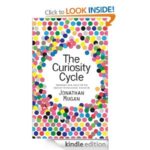Recommended Resources
The Curiosity Cycle by Jonathan Mugan
 I’ve already written previously on the EYFS Forum about how Twitter can give you some surprising links (EYFS Forum).
I’ve already written previously on the EYFS Forum about how Twitter can give you some surprising links (EYFS Forum).
The one I detailed in that particular article was a book by Jonathan Mugan. Just to recap, Jonathan had tweeted to me after reading the schema and fairies post. He had done some research on schema as part of his Ph.D. on robots learning and has subsequently written a book called The Curiosity Cycle. I had a quick read of the prologue and realised how relevant this book is to children’s learning. I bought it on Kindle and can now confirm that it is a fascinating viewpoint on how and why we should encourage and nurture children’s curiosity above all else.
The book is really about how we “actively construct” (page 4) our knowledge of the world as children. What this means is that we use a complicated web of previous information, new information, reinforcement and reinterpretation to make sense of the world around us.
Part 1 of the book investigates concepts and models of our knowledge acquisition. This includes the idea of “supple thinking” which means that a child can adapt and be flexible to different circumstances they find themselves in. The example given is that by learning maths by rote, rather than thoroughly understanding the underpinning concept, is not useful. It will not allow your child to move forward in maths because they won’t have the flexibility of mind to understand, for example, that ‘x’ can represent many different numbers.
There are many great examples of discussion topics and ideas for adults and children in part 1. These are mainly aimed at school-age children, although I think some of the more curious preschoolers would understand some of the concepts. One really useful tip that I think everyone could use, is to be specific when talking to young children. So rather than saying to a child “Please can you get me that thing from over there?” It is much more instructive to say “Please can you get me the small blue cup from the top of the medium bookcase?” Apart from the vocabulary, it also encourages children to be specific when expressing themselves.
I really love the idea of making the ordinary absurd. For example, exploring the idea that plane travel is flying in the sky sat in a chair or that a tree seed can transform from something tiny you can hold in your palm into a tree, which is bigger than your house. Sometimes as adults it is easy to become jaded about these “ordinary” things that happen all around us. It is a great reminder that these are amazing things and should be shared as such with children.
The second part of the book is about children as “embodied social beings”. It investigates the idea that children are good at recognising patterns and understanding abstract ideas. Again, there are some great ideas to support this way of thinking. This includes social situations, humour and understanding abstract ideas – with mention of Piaget’s conservation of mass.
Emotional embodiment on page 86, talks about “hot” and “cold” states, for when someone is (respectively) “visceral charged” or “cool, calm, rational”. I think this is an interesting way of defining emotions for a young child and could well be used to help children to verbalise and regulate their emotional states.
In part 3 of this book we learn how computers are everywhere and are growing in their capacity, both in terms of memory storage and ability to make links – “to think”. However, computers are still a long way behind the average preschooler in being able to think flexibly and creatively. This is currently what gives humans the edge over computers. Mugan goes on to explain how we can support children to be more creative in this technological world and give them the advantage for their world of the future.
There is a particularly timely notice about privacy, considering that research has found that children as young as 5 are using Facebook, (bbc news website) and how this may affect people in the future.
Jonathan Mugan concludes with a particularly sobering thought – “increasingly rapid change is coming and this change will require engaged curiosity to understand it” (page 150). I wonder if this is truly achieved through the EYFS or 2-year-old progress checks? This is why it is essential that practitioners are motivated, curious and involved.
This really is a superb book, which has made me re-evaluate how I communicate with my children. The Kindle version on the computer allows you to click through on the websites and research links, which gives a whole new level of reading material.
I would say this is essential reading for anyone who is passionate about encouraging curiosity and stimulating individuality and creativity in their children.
It is available on Kindle at Amazon
Kathy Brodie
https://www.kathybrodie.com/author/kathy-brodie/Kathy Brodie is an author, Early Years Professional and Trainer specialising in online training and courses. She is the founder and host of the Early Years Summit and Early Years TV, weekly Professional Development for Early Years practitioners and educators.
